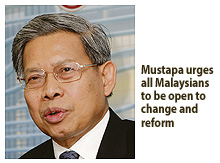
RANKINGS have now become commonplace. Countries are being benchmarked based on the level of transparency and the integrity of their institutions. In the economic sphere, the competitiveness of countries is evaluated on an annual basis by a number of institutions.
These rankings have played a role in shaping people’s perceptions about countries and institutions. They may not be entirely accurate, but many take heed of the assessments. And, even if they do not provide complete assessments, they do influence decision-making.
Each year, the Ministry of International Trade and Industry (Miti) monitors the results of three major international reports on countries’ competitiveness, namely the World Competitiveness Yearbook (WCY) 2010 by the Institute of Management Development (IMD), the Global Competitiveness Report (GCR) 2010-2011 by the World Economic Forum (WEF) and the Doing Business (DB) Report by the World Bank.
Many parties may not agree with the criteria or the scores and, in some countries, the publication of these reports have stirred some controversy. In an open society that we are in today, we have to accept and deal with the issues head on.
In May this year, the WCY placed Malaysia within its top 10 list of most competitive countries, moving us up eight positions. This is an impressive achievement.
In the latest report released last week, the GCR ranked Malaysia at 26th position in a list of 139 countries, two positions lower than the previous year. The DB report for the year is expected to be published in November this year.
Questions have been raised as to why the results vary so significantly. One explanation lies in the different methodologies adopted by each organisation responsible for the reports.
These rankings have played a role in shaping people’s perceptions about countries and institutions. They may not be entirely accurate, but many take heed of the assessments. And, even if they do not provide complete assessments, they do influence decision-making.
Each year, the Ministry of International Trade and Industry (Miti) monitors the results of three major international reports on countries’ competitiveness, namely the World Competitiveness Yearbook (WCY) 2010 by the Institute of Management Development (IMD), the Global Competitiveness Report (GCR) 2010-2011 by the World Economic Forum (WEF) and the Doing Business (DB) Report by the World Bank.
Many parties may not agree with the criteria or the scores and, in some countries, the publication of these reports have stirred some controversy. In an open society that we are in today, we have to accept and deal with the issues head on.
In May this year, the WCY placed Malaysia within its top 10 list of most competitive countries, moving us up eight positions. This is an impressive achievement.
In the latest report released last week, the GCR ranked Malaysia at 26th position in a list of 139 countries, two positions lower than the previous year. The DB report for the year is expected to be published in November this year.
Questions have been raised as to why the results vary so significantly. One explanation lies in the different methodologies adopted by each organisation responsible for the reports.
